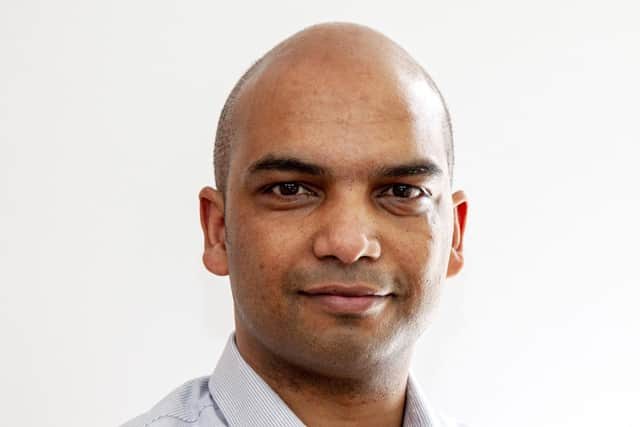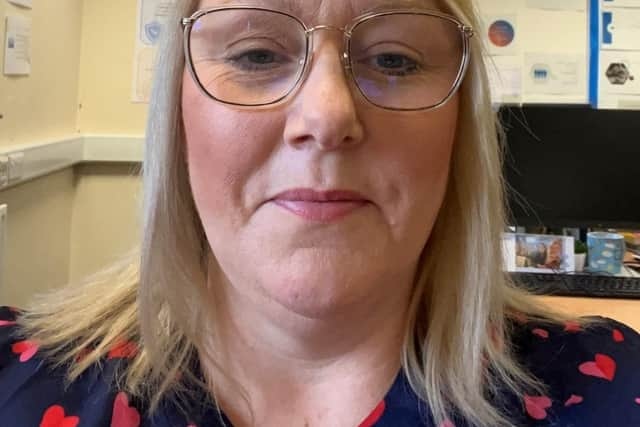'Different way of thinking' as Wigan's virtual hospital wards are a success
and live on Freeview channel 276
Wrightington, Wigan and Leigh Teaching Hospitals NHS Foundation Trust (WWL) has been leading the way with virtual wards, which allow patients to stay at home but be closely monitored by medical staff using technology.
They were officially opened in January 2022, developed from a scheme where patients were supported at home during the coronavirus pandemic.


Advertisement
Hide AdAdvertisement
Hide AdThe virtual wards are proving to be a success, with the model being rolled out by other hospitals across the country and even further afield.
A total of 1,620 patients with a range of health issues have now been treated on the borough’s virtual wards.
Respiratory consultant and deputy medical director Dr Abdul Ashish said: “It’s a very helpful service to support patients. It’s a very safe service. We have seen 1,600 patients and had virtually no problems at all.
"Between 95 and 99 per cent of patients say they would have it any day, rather than coming back to the hospital. We know from the patients’ survey that it’s an amazingly popular service with the patients, so we know it’s right.”


Advertisement
Hide AdAdvertisement
Hide AdInitially the virtual wards followed a medical pathway, with respiratory patients being treated there and then those with other conditions.
But they can now be used for many different patients, providing they consent to using the technology and are not allergic to the small piece of metal used to monitor them.
It can be a “step down” service, to continue supporting patients after care in hospital, or a “step up” service, allowing people to get the support they need at home rather than being admitted.
The “step up” service can see people referred by their GP and means they do not need to attend the A&E department or be admitted to a hospital bed.
Advertisement
Hide AdAdvertisement
Hide AdA new surgical pathway has been developed as part of the “step down” service, with 89 patients so far going home to recover after surgery, rather than staying in hospital.
Patients of all ages can use the virtual wards, with WWL’s oldest patient so far being 96, and the technology monitoring them is simple to use.
Currently the virtual wards can cater for 100 patients, though the trust has surpassed this in recent weeks and is on target to reach 150 virtual beds by March.
Dr Ashish said: “Hospitals are getting more overcrowded, corridor care is happening across the country. This is a very safe and effective way to engage both acute and community services to the wrap-around care we provide for patients.
Advertisement
Hide AdAdvertisement
Hide Ad"We are trailblazers in terms of our services in Greater Manchester and we are one of the services often quoted even at a national level, simply because of the engagement from the team and the response and the number of patients we have across a wide variety of conditions that we manage.
"We don’t restrict patients and say they can only go if they have a heart or lung issue. It’s a very patient-centred service.”
There are many benefits to patients being treated at home, not least that they free up hospital beds for patients who may need more care. This will be key during the busy winter months.
For patients, they are not stuck in bed, following set meal times, becoming deconditioned or being put at risk of acquiring an infection.
Advertisement
Hide AdAdvertisement
Hide AdAlison Chadwick, clinical quality lead (virtual care) in WWL’s community division, saw the benefits first-hand when her mother had a heart attack earlier this year and struggled to sleep while on a coronary care ward.
She was sent home to a virtual ward and says just a few hours later, having slept in her own bed, she “looked human again”.
Dr Ashish and Mrs Chadwick are continuing to grow the virtual wards and are working with A&E staff to have people treated on the wards at home.
They are developing a care home pathway, which staff can use rather than phoning for an ambulance when residents are unwell and they do not have access to a doctor.
Advertisement
Hide AdAdvertisement
Hide AdMrs Chadwick said: “What we usually find is, because the vast majority of staff are untrained, they would ring for an ambulance and the patient unfortunately comes to A&E, often inappropriately, spending long periods of time in a chair or on a trolley waiting for assessment and becoming tired, when that’s not necessary.”
It is hoped the pilot project will see residents referred to the virtual ward instead, allowing them to stay at the care home and for staff to know they are being monitored by medics.
The virtual wards are being continuously developed and best practice is shared with other hospitals rolling out their own wards.
Mrs Chadwick said: “We have been asked to do webinars, to speak or to write for various different organisations or conferences. Our kit provider had me present at their first symposium, which invited everyone using their kit around the country.
Advertisement
Hide AdAdvertisement
Hide Ad"I think it’s fair to say we are consistently being asked across Greater Manchester.”
Mrs Chadwick and Dr Ashish have been asked to speak in London to trusts across the country and a representative from a healthcare organisation in Ireland has been to Wigan to learn about the virtual wards.
They have also been testing out new equipment developed by the supplier.
As health organisations around the country are following WWL’s lead, people in the borough are being urged to support the virtual wards.
Advertisement
Hide AdAdvertisement
Hide AdDr Ashish believes it is “empowering” for patients to be treated at home and a “viable alternative to A&E”.
He said: “We need support from our patients, GP colleagues and community colleagues to align the vision and try to manage patients as close to home as possible.
"Hospitals should only be for the really needy, sickest patients. I think it requires a different way of thinking.”